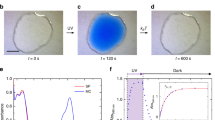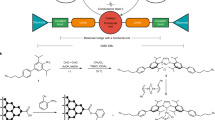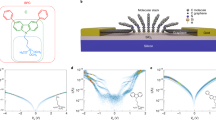Abstract
The ability to measure the behavior of a single molecule during a reaction implies the detection of inherent dynamic and static disordered states, which may not be represented when measuring ensemble averages. Here, we describe the building of devices with graphene–molecule–graphene single-molecule junctions integrated into an electrical circuit. These devices are simple to build and are stable, showing tolerance to mechanical changes, solution environment and voltage stimulation. The design of a conductive channel based on a single molecule enables single-molecule detection and is sensitive to variations in physical properties and chemical structures of the detected molecules. The on-chip setup of single-molecule junctions further offers complementary metal–oxide–semiconductor (CMOS) compatibility, enabling logic functions in circuit elements, as well as deciphering of reaction intermediates. We detail the experimental procedure to prepare graphene transistor arrays as a basis for single-molecule junctions and the preparation of nanogapped carboxyl-terminal graphene electrodes by using electron-beam lithography and oxygen plasma etching. We describe the basic design of a molecular bridge with desired functions and terminals to form covalent bonds with electrode arrays, via a chemical reaction, to construct stably integrated single-molecule devices with a yield of 30−50% per chip. The immobilization of the single molecules is then characterized by using inelastic electron tunneling spectra, single-molecule imaging and fluorescent spectra. The whole protocol can be implemented within 2 weeks and requires users trained in using ultra-clean laboratory facilities and the aforementioned instrumentation.
This is a preview of subscription content, access via your institution
Access options
Access Nature and 54 other Nature Portfolio journals
Get Nature+, our best-value online-access subscription
$29.99 / 30 days
cancel any time
Subscribe to this journal
Receive 12 print issues and online access
$259.00 per year
only $21.58 per issue
Buy this article
- Purchase on Springer Link
- Instant access to full article PDF
Prices may be subject to local taxes which are calculated during checkout





Similar content being viewed by others
Data availability
The main data discussed in this protocol are available in the supporting primary research paper46. The raw datasets are too large to be publicly shared but are available for research purposes from the corresponding author upon reasonable request.
References
Coontz, R. & Hanson, B. Not so simple. Science 305, 957 (2004).
Barkai, E., Jung, Y. J. & Silbey, R. Theory of single-molecule spectroscopy: beyond the ensemble average. Annu. Rev. Phys. Chem. 55, 457–507 (2004).
Zrimsek, A. B. et al. Single-molecule chemistry with surface- and tip-enhanced Raman spectroscopy. Chem. Rev. 117, 7583–7613 (2017).
Lu, H. P., Xun, L. & Xie, X. S. Single-molecule enzymatic dynamics. Science 282, 1877–1882 (1998).
Liu, C. et al. Single polymer growth dynamics. Science 358, 352–355 (2017).
Florin, E. L., Moy, V. T. & Gaub, H. E. Adhesion forces between individual ligand-receptor pairs. Science 264, 415–417 (1994).
Li, Y., Yang, C. & Guo, X. Single-molecule electrical detection: a promising route toward the fundamental limits of chemistry and life science. Acc. Chem. Res. 53, 159–169 (2020).
Xin, N. et al. Concepts in the design and engineering of single-molecule electronic devices. Nat. Rev. Phys. 1, 211–230 (2019).
Venkatesan, B. M. & Bashir, R. Nanopore sensors for nucleic acid analysis. Nat. Nanotechnol. 6, 615–624 (2011).
Aviram, A. & Ratner, M. A. Molecular rectifiers. Chem. Phys. Lett. 29, 277–283 (1974).
Xiang, D., Wang, X., Jia, C., Lee, T. & Guo, X. Molecular-scale electronics: from concept to function. Chem. Rev. 116, 4318–4440 (2016).
Li, T., Hu, W. & Zhu, D. Nanogap electrodes. Adv. Mater. 22, 286–300 (2010).
Jia, C. & Guo, X. Molecule-electrode interfaces in molecular electronic devices. Chem. Soc. Rev. 42, 5642–5660 (2013).
Su, T. A., Neupane, M., Steigerwald, M. L., Venkataraman, L. & Nuckolls, C. Chemical principles of single-molecule electronics. Nat. Rev. Mater. 1, 16002 (2016).
Xu, B. & Tao, N. Measurement of single-molecule resistance by repeated formation of molecular junctions. Science 301, 1221–1223 (2003).
Venkataraman, L., Klare, J. E., Nuckolls, C., Hybertsen, M. S. & Steigerwald, M. L. Dependence of single-molecule junction conductance on molecular conformation. Nature 442, 904–907 (2006).
Reed, M. A., Zhou, C., Muller, C. J., Burgin, T. P. & Tour, J. M. Conductance of a molecular junction. Science 278, 252–254 (1997).
Park, H., Lim, A. K. L., Alivisatos, A. P., Park, J. & McEuen, P. L. Fabrication of metallic electrodes with nanometer separation by electromigration. Appl. Phys. Lett. 75, 301–303 (1999).
Park, J. et al. Coulomb blockade and the Kondo effect in single-atom transistors. Nature 417, 722–725 (2002).
Gehring, P. et al. Field-effect control of graphene–fullerene thermoelectric nanodevices. Nano Lett. 17, 7055–7061 (2017).
Burzurí, E. et al. Sequential electron transport and vibrational excitations in an organic molecule coupled to few-layer graphene electrodes. ACS Nano 10, 2521–2527 (2016).
Burzurí, E. et al. Spin-state dependent conductance switching in single molecule-graphene junctions. Nanoscale 10, 7905–7911 (2018).
Island, J. O. et al. Fabrication of hybrid molecular devices using multi-layer graphene break junctions. J. Phys. Condens. Matter 26, 474205 (2014).
Prins, F. et al. Room-temperature gating of molecular junctions using few-layer graphene nanogap electrodes. Nano Lett. 11, 4607–4611 (2011).
Lau, C. S. et al. Redox-dependent Franck–Condon blockade and avalanche transport in a graphene-fullerene single-molecule transistor. Nano Lett. 16, 170–176 (2015).
Limburg, B. et al. Anchor groups for graphene-porphyrin single-molecule transistors. Adv. Funct. Mater. 28, 1803629 (2018).
Mol, J. A. et al. Graphene-porphyrin single-molecule transistors. Nanoscale 7, 13181–13185 (2015).
Thomas, J. O. et al. Understanding resonant charge transport through weakly coupled single-molecule junctions. Nat. Commun. 10, 4628 (2019).
Pei, T. et al. Exchange-induced spin polarization in a single magnetic molecule junction. Nat. Commun. 13, 4506 (2022).
Zhao, S. et al. Charge transport through single-molecule bilayer-graphene junctions with atomic thickness. Chem. Sci. 13, 5854–5859 (2022).
Cao, Y. et al. Building high-throughput molecular junctions using indented graphene point contacts. Angew. Chem. Int. Ed. Engl. 51, 12228–12232 (2012).
Gu, C. H., Su, D. K., Jia, C. C., Ren, S. Z. & Guo, X. F. Building nanogapped graphene electrode arrays by electroburning. RSC Adv. 8, 6814–6819 (2018).
Guo, X. et al. Covalently bridging gaps in single-walled carbon nanotubes with conducting molecules. Science 311, 356–359 (2006).
Jia, C. et al. Covalently bonded single-molecule junctions with stable and reversible photoswitched conductivity. Science 352, 1443–1445 (2016).
Jia, C., Ma, B., Xin, N. & Guo, X. Carbon electrode-molecule junctions: a reliable platform for molecular electronics. Acc. Chem. Res. 48, 2565–2575 (2015).
Xin, N. et al. Stereoelectronic effect-induced conductance switching in aromatic chain single-molecule junctions. Nano Lett. 17, 856–861 (2017).
Meng, L. et al. Atomically precise engineering of single-molecule stereoelectronic effect. Angew. Chem. Int. Ed. Engl. 60, 12274–12278 (2021).
Yang, C. et al. Complete deciphering of the dynamic stereostructures of a single aggregation-induced emission molecule. Matter 5, 1224–1234 (2022).
Wen, H. et al. Complex formation dynamics in a single-molecule electronic device. Sci. Adv. 2, e1601113 (2016).
Zhou, C. et al. Direct observation of single-molecule hydrogen-bond dynamics with single-bond resolution. Nat. Commun. 9, 807 (2018).
Liu, Z. et al. A single-molecule electrical approach for amino acid detection and chirality recognition. Sci. Adv. 7, eabe4365 (2021).
Chen, S. et al. Real-time observation of the dynamics of an individual rotaxane molecular shuttle using a single-molecule junction. Chem 8, 243–252 (2022).
Guo, Y., Yang, C., Jia, C. & Guo, X. Accurate single-molecule indicator of solvent effects. JACS Au 1, 2271–2279 (2021).
Gu, C. et al. Label-free dynamic detection of single-molecule nucleophilic-substitution reactions. Nano Lett. 18, 4156–4162 (2018).
Yang, C. et al. Single-molecule electrical spectroscopy of organocatalysis. Matter 4, 2874–2885 (2021).
Yang, C. et al. Unveiling the full reaction path of the Suzuki–Miyaura cross-coupling in a single-molecule junction. Nat. Nanotechnol. 16, 1214–1223 (2021).
Yang, C. et al. Electric field-catalyzed single-molecule Diels-Alder reaction dynamics. Sci. Adv. 7, eabf0689 (2021).
Guo, Y. et al. Accurate single-molecule kinetic isotope effects. J. Am. Chem. Soc. 144, 3146–3153 (2022).
Meng, L. et al. Side-group chemical gating via reversible optical and electric control in a single molecule transistor. Nat. Commun. 10, 1450 (2019).
Xin, N. et al. Tuning charge transport in aromatic-ring single-molecule junctions via ionic-liquid gating. Angew. Chem. Int. Ed. Engl. 57, 14026–14031 (2018).
Xin, N. et al. Control of unipolar/ambipolar transport in single‐molecule transistors through interface engineering. Adv. Electron. Mater. 6, 1901237 (2020).
Xin, N. et al. Tunable symmetry-breaking-induced dual functions in stable and photoswitched single-molecule junctions. J. Am. Chem. Soc. 143, 20811–20817 (2021).
Stefani, D. et al. Large conductance variations in a mechanosensitive single-molecule junction. Nano Lett. 18, 5981–5988 (2018).
Vazquez, H. et al. Probing the conductance superposition law in single-molecule circuits with parallel paths. Nat. Nanotechnol. 7, 663–667 (2012).
Greenwald, J. E. et al. Highly nonlinear transport across single-molecule junctions via destructive quantum interference. Nat. Nanotechnol. 16, 313–317 (2020).
Zhang, L. et al. Electrochemical and electrostatic cleavage of alkoxyamines. J. Am. Chem. Soc. 140, 766–774 (2018).
Venkataraman, L. et al. Electronics and chemistry: varying single-molecule junction conductance using chemical substituents. Nano Lett. 7, 502–506 (2007).
Zhang, Y. et al. Distinguishing diketopyrrolopyrrole isomers in single-molecule junctions via reversible stimuli-responsive quantum interference. J. Am. Chem. Soc. 140, 6531–6535 (2018).
Su, T. A., Li, H., Steigerwald, M. L., Venkataraman, L. & Nuckolls, C. Stereoelectronic switching in single-molecule junctions. Nat. Chem. 7, 215–220 (2015).
Huang, S. et al. Identifying single bases in a DNA oligomer with electron tunnelling. Nat. Nanotechnol. 5, 868–873 (2010).
Zhao, Y. et al. Single-molecule spectroscopy of amino acids and peptides by recognition tunnelling. Nat. Nanotechnol. 9, 466–473 (2014).
Zhu, J. et al. Solution-processable carbon nanoelectrodes for single-molecule investigations. J. Am. Chem. Soc. 138, 2905–2908 (2016).
Xu, Q. et al. Single electron transistor with single aromatic ring molecule covalently connected to graphene nanogaps. Nano Lett. 17, 5335–5341 (2017).
Caneva, S. et al. Mechanically controlled quantum interference in graphene break junctions. Nat. Nanotechnol. 13, 1126–1131 (2018).
El Abbassi, M. et al. Robust graphene-based molecular devices. Nat. Nanotechnol. 14, 957–961 (2019).
Gehring, P. et al. Distinguishing lead and molecule states in graphene-based single-electron transistors. ACS Nano 11, 5325–5331 (2017).
Nef, C. et al. High-yield fabrication of nm-size gaps in monolayer CVD graphene. Nanoscale 6, 7249–7254 (2014).
Cully, J. J., Swett, J. L., Willick, K., Baugh, J. & Mol, J. A. Graphene nanogaps for the directed assembly of single-nanoparticle devices. Nanoscale 13, 6513–6520 (2021).
Lau, C. S., Mol, J. A., Warner, J. H. & Briggs, G. A. D. Nanoscale control of graphene electrodes. Phys. Chem. Chem. Phys. 16, 20398–20401 (2014).
Agrawal, S., Raghuveer, M. S., Kroger, R. & Ramanath, G. Electrical current-induced structural changes and chemical functionalization of carbon nanotubes. J. Appl. Phys. 100, 094314 (2006). 21.
Ullmann, K. et al. Single-molecule junctions with epitaxial graphene nanoelectrodes. Nano Lett. 15, 3512–3518 (2015).
Tincu, B. et al. Investigation of plasma-assisted functionalization of pristine single layer graphene. Chem. Phys. Lett. 789, 139330 (2022).
Cao, Y., Dong, S., Liu, S., Liu, Z. & Guo, X. Toward functional molecular devices based on graphene molecule junctions. Angew. Chem. Int. Ed. Engl. 52, 3906–3910 (2013).
Imai-Imada, M. et al. Orbital-resolved visualization of single-molecule photocurrent channels. Nature 603, 829–834 (2022).
Acknowledgements
We acknowledge primary financial support from the National Key R&D Program of China (2021YFA1200101 and 2022YFE0128700), the National Natural Science Foundation of China (22150013, 21727806 and 21933001), the Tencent Foundation through the XPLORER PRIZE “Frontiers Science Center for New Organic Matter” at Nankai University (63181206) and the Natural Science Foundation of Beijing (2222009).
Author information
Authors and Affiliations
Contributions
Chen Yang, Caiyao Yang and X.G. designed and created the figures. Chen Yang, Caiyao Yang, Y.G. and J.F. performed the experiments and wrote the manuscript. X.G. supervised the research and edited the manuscript.
Corresponding author
Ethics declarations
Competing interests
The authors declare no competing interests.
Peer review
Peer review information
Nature Protocols thanks the anonymous reviewers for their contribution to the peer review of this work.
Additional information
Publisher’s note Springer Nature remains neutral with regard to jurisdictional claims in published maps and institutional affiliations.
Related links
Key references using this protocol
Jia, C. et al. Science 352, 1443−1445 (2016): https://doi.org/10.1126/science.aaf6298
Yang, C. et al. Nat. Nanotechnol. 16, 1214−1223 (2021): https://doi.org/10.1038/s41565-021-00959-4
Yang, C. et al. Sci. Adv. 7, eabf0689 (2021): https://doi.org/10.1126/sciadv.abf0689
Supplementary information
Supplementary Information
Supplementary Note and Figs. 1–12.
Rights and permissions
Springer Nature or its licensor (e.g. a society or other partner) holds exclusive rights to this article under a publishing agreement with the author(s) or other rightsholder(s); author self-archiving of the accepted manuscript version of this article is solely governed by the terms of such publishing agreement and applicable law.
About this article
Cite this article
Yang, C., Yang, C., Guo, Y. et al. Graphene–molecule–graphene single-molecule junctions to detect electronic reactions at the molecular scale. Nat Protoc 18, 1958–1978 (2023). https://doi.org/10.1038/s41596-023-00822-x
Received:
Accepted:
Published:
Issue Date:
DOI: https://doi.org/10.1038/s41596-023-00822-x
This article is cited by
-
Regulation of quantum spin conversions in a single molecular radical
Nature Nanotechnology (2024)
-
The role of halogens in Au–S bond cleavage for energy-differentiated catalysis at the single-bond limit
Nature Communications (2023)
Comments
By submitting a comment you agree to abide by our Terms and Community Guidelines. If you find something abusive or that does not comply with our terms or guidelines please flag it as inappropriate.



